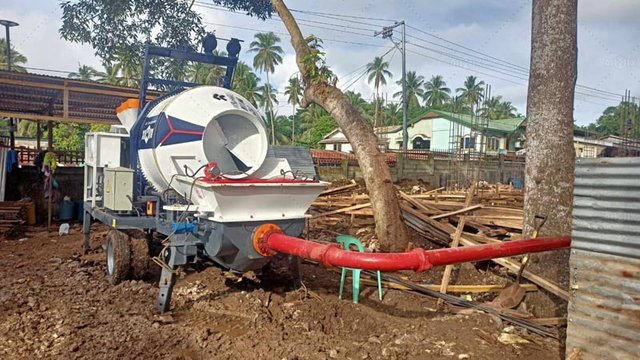How to Transfer Concrete Pumps?
Transferring a concrete pump is an essential aspect of construction logistics, especially when working on large-scale projects that require the efficient movement of concrete from the mixer to the desired location. Whether you're moving a stationary pump or a concrete pump truck, understanding the proper methods for transportation ensures safety, cost-effectiveness, and minimal downtime. This article explores the key considerations and best practices for transferring concrete pumps safely and efficiently, making sure your construction project stays on track.
1. Planning the Transfer Process
Before transferring a concrete pump(bomba de hormigón), it is important to plan the logistics carefully. This planning phase involves determining the best route for transportation, ensuring the safety of the surrounding environment, and understanding the necessary equipment for the move. The size and weight of the concrete pump, as well as the terrain and access points of the construction site, should be taken into account. If you're using a concrete pump truck, the planning process becomes even more crucial, as these vehicles are large and require careful maneuvering.
Route and Access Evaluation
When planning the transfer, start by evaluating the access routes to ensure that the concrete pump or concrete pump truck can be safely transported to the site. If you're moving a larger concrete pump truck, it's essential to assess road conditions, overhead clearance, and any narrow or tight spaces that may be difficult to navigate. It’s advisable to consult with logistics professionals or use mapping tools to identify the safest and most efficient path to the destination.
Traffic Management
If you're transporting the equipment through a busy construction site or a public road, managing traffic flow is critical. Traffic control measures such as road signs, flaggers, and barricades should be set up to ensure the safe movement of the concrete pump. You may also need permits for transporting oversized equipment, especially in urban areas or on highways.

2. Proper Equipment for the Transfer
The right equipment is essential for transferring concrete pumps effectively. Depending on whether you're moving a stationary concrete pump or a mobile concrete pump truck(autobomba de concreto), the tools required for the move may differ. Below are some considerations to keep in mind when selecting the appropriate equipment:
Using a Crane or Forklift for Stationary Concrete Pumps
For stationary concrete pumps, a crane or forklift is often required to load and unload the pump from flatbeds or trailers. When using a crane, ensure that the lift capacity matches the weight of the pump. The crane operator should be experienced in handling heavy equipment to prevent accidents or damage. If using a forklift, ensure that it is rated to carry the load and is stable on uneven terrain.
Transporting Concrete Pump Trucks
When transporting a concrete pump truck, the process differs as the truck itself is designed for mobility. However, special care must be taken when driving the truck over long distances or through difficult terrain. If you're moving a concrete pump truck across large distances, it’s advisable to hire a professional transport company with the necessary trailers and equipment to handle heavy-duty vehicles. Ensure that the concrete pump truck is secured properly to prevent any movement during transit.
Securing the Equipment During Transport
Whether you’re moving a stationary concrete pump or a concrete pump truck, securing the equipment during transport is essential to prevent damage or accidents. Use heavy-duty straps, chains, and tie-downs to secure the pump or truck to the transport vehicle. Properly securing the concrete pump minimizes the risk of movement, vibration, and potential hazards that can occur during transit.
3. Safety Precautions During the Transfer
Safety is a primary concern when transferring concrete pumps, especially given the size and weight of the equipment. Whether you’re moving a concrete pump truck or a stationary pump, take the following precautions to ensure the safety of everyone involved:
Personnel Safety
Ensure that the team members involved in the transfer are equipped with the necessary personal protective equipment (PPE), such as hard hats, gloves, and safety boots. Additionally, only trained and certified personnel should operate heavy machinery such as cranes, forklifts, or concrete pump trucks. Proper training and supervision are essential to reduce the risk of accidents and ensure a smooth transfer process.
Inspection of Equipment
Before the transfer begins, inspect the concrete pump and transport vehicle for any signs of wear, damage, or malfunctions. Regular inspections of tires, hydraulic systems, and mechanical components should be conducted to prevent breakdowns during the transfer. Ensure that the transport vehicle is in good condition and that the concrete pump is properly maintained before moving it.
Weather Conditions
Weather conditions can significantly affect the transfer process, especially when moving large equipment like concrete pump trucks. Strong winds, rain, or snow can make transportation hazardous. Before proceeding with the transfer, check weather forecasts and delay the move if unsafe conditions are predicted. It's also crucial to monitor the weather during the transfer and make adjustments if necessary.

4. Post-Transfer Setup
Once the concrete pump has been successfully transferred to the construction site, it’s time to set up and prepare it for operation. For stationary concrete pumps, this involves securing the pump in its designated position and connecting it to the necessary pipeline or hoses. Ensure that all hydraulic lines, electrical systems, and safety features are correctly installed and functioning before use. For concrete pump trucks, check the boom and hose connections, and make sure the truck is positioned on stable ground to prevent tipping.
Conclusion
Transferring concrete pumps involves careful planning, proper equipment, and a strong focus on safety. Whether you're moving a stationary concrete pump or a concrete pump truck, taking the right precautions ensures the successful and efficient relocation of equipment on the construction site. By following best practices, you can avoid costly delays and ensure that your concrete pumping operations run smoothly, contributing to the overall success of your construction projects.